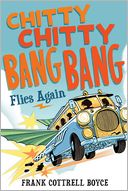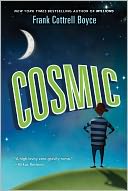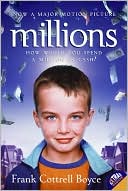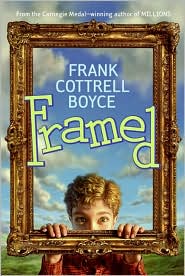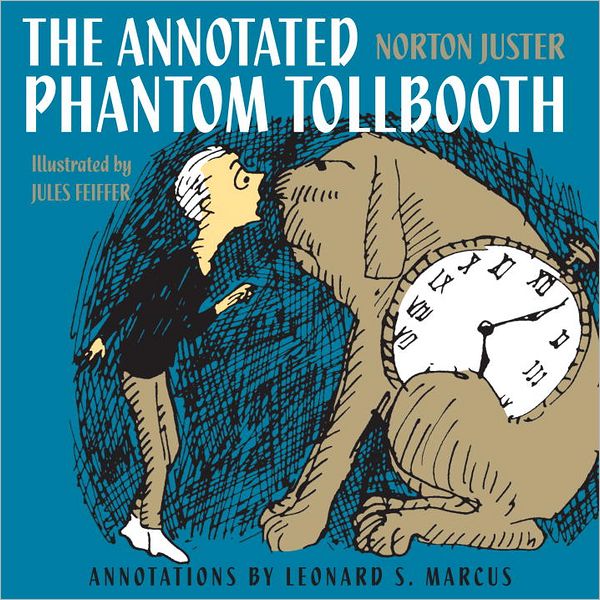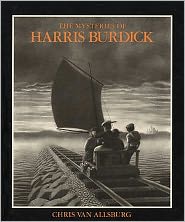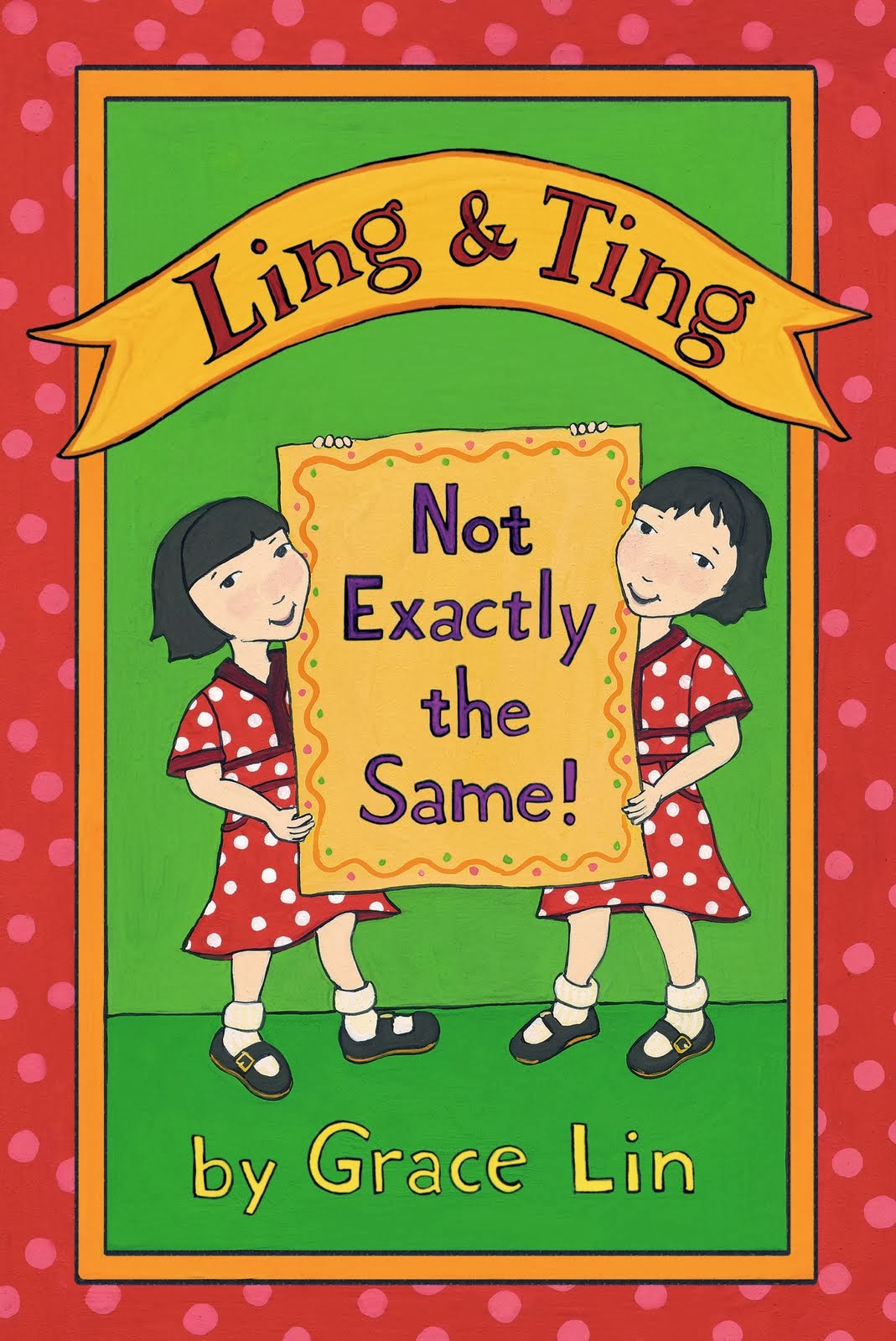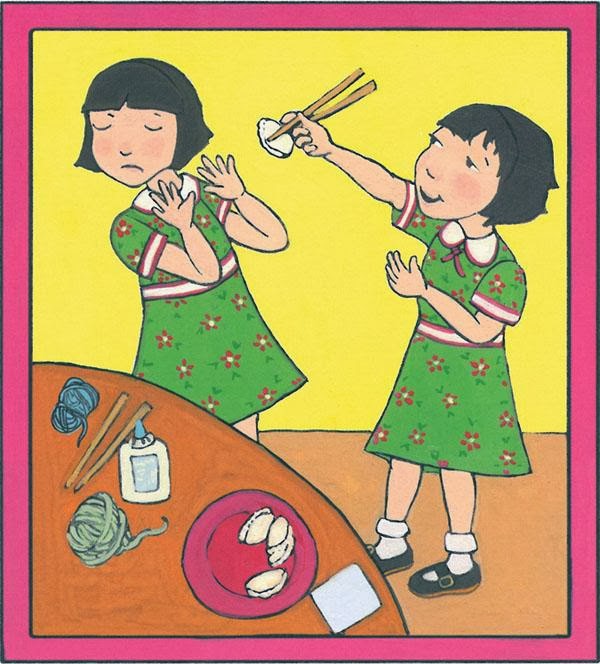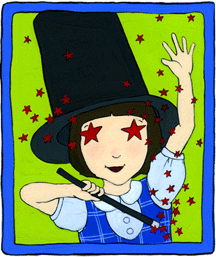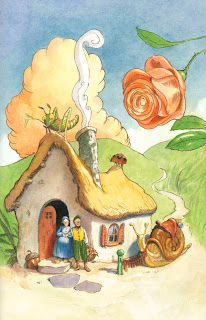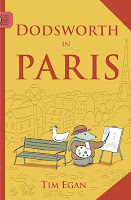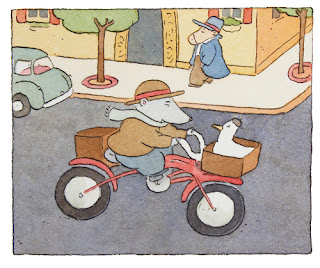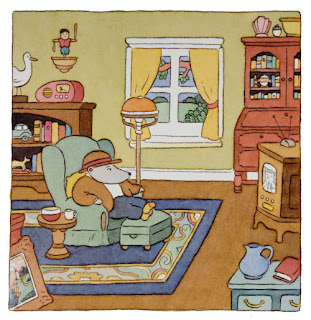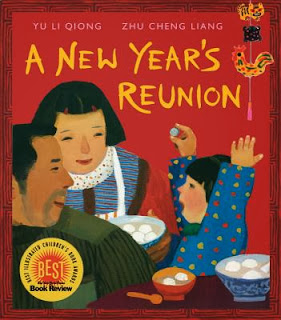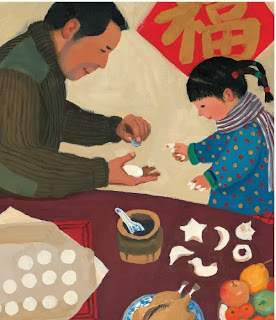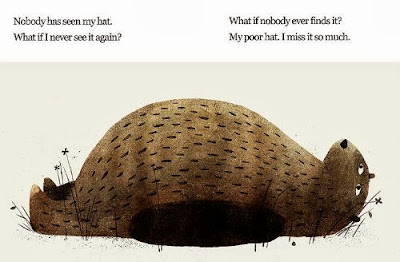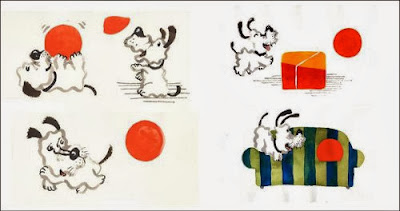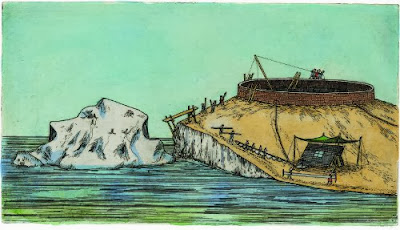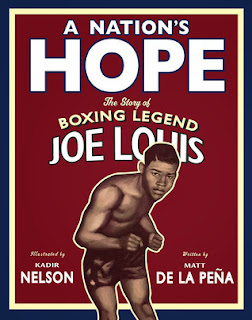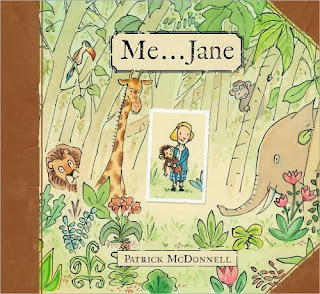After watching the movie Millions (based on the book by Frank Cottrell Boyce) with my family four or five years ago, I knew that I wanted to read his books for kids. Americans may not know this, but Boyce is a well respected screenwriter in the UK and has written four other kid's books (see below) including the soon to be published Chitty-Chitty-Bang-Bang Flies Again. Millions is thoughtful, suspenseful and sweet, in a good way. The kids in the movie face some tough situations that they have to think and feel their way out of. After reading his newest book, The Unforgotten Coat, I wonder if this is a hallmark of Frank Cottrell Boyce's style? Although a relatively short book, I did not intend to read The Unforgotten Coat from cover to cover when I picked it up. But, an hour or so later as I sat on the couch with tears running down my face, that is exactly what I had done. I often find myself crying at the end of a really good kid's book and I never know if I should mention that in a review or not. Kids don't cry when they read these books and that's fine. Their senses of empathy aren't quite fully operational in the tween and teen years. But, I have decided to reveal my little secret now because when a book touches me deeply enough to make me shed a tear, that tends to be a good indicator of other gratifying qualities that might make the book a valuable read to others, young or old.
The The Unforgotten Coat is meant to look as much as possible like the blue notebook that the narrator, Julie, finds in the pocket of a long forgotten coat. The first thing we see after the title page is the cover of the notebook with a hand drawn coat on a hanger. The inside of the notebook reveals a polaroid photo of two girls and two boys in their school uniforms, mugging for the camera. Although it is clear in the first paragraph of the book that the Julie reading this notebook and telling the story is now an adult, she quickly slips into the voice of the eleven year old child she was when the picture was taken. That is the beauty and the genius of Boyce's writing. Although this is a short book, he immerses you in the mind and life of his characters so completely that it seems like you have known them for much longer. In the first four pages Julie goes from trying to get a boy to pay attention to her and finessing repeated invitations to spend the afternoon at the house of a girl with a mother who lets her play with make up (she even says, when defending her ability to recall specific things from so long ago, "How do I remember my thoughts so clearly? Because those were the only thoughts I had in the first two terms of Year Six: 1: Mimi, can I come back to your house? 2: Shocky, please notice me.") to becoming a girl with a serious mission. Julie and Mimi spot two kids, "one big and one little, the big one holding the little one's hand - staring through the railings of the playground. The little one was wearing a furry hat, and they had identical coats. Crazy coats - long with fur inside. But any coat would have looked crazy. The sun was beating down. The asphalt in the car park was melting." The girls have a brief exchange with the bigger of the boys and, when they return to the classroom, they learn that he is a new student in their class.
Chingis, the new boy, has brought his brother to class with him. Upon being introduced to the class Chingis commences a very funny, tense exchange with the teacher. Chingis insists that his brother be called Nergui, instead of his real name, which he will not permit the teacher to be say out loud, and be allowed to stay in this class because Chingis is bound to "take care of him. Protect him." Mrs Spendlove agrees to let Nergui spend the day in their class but insists he remove his huge hat. Chingis insists he leave it on, saying that "maybe he will go insane and kill everyone" if it is removed, then asks the class, "When you want your eagle to be calm, what do you do?" Of course no one knows, and Chingis tells them that you cover its eyes with a hood, saying, "When you want the eagle to fly and kill, you take off the hood. My brother is my eagle. With his hood on, he is calm enough. Without his hood, I don't know what he will be like." Upon hearing this Julie thinks,
Year Six. We had been at school for six years, and until that moment, I thought I had probably learned all I would ever need to learn. I knew how to figure out the volume of a cube. I knew who had painted the Sunflowers. I could tell you the history of Saint Lucia. I knew about lines of the Tudors and lines of symmetry and the importance of eating five portions of fruit a day. But in all that time, I had never had a lesson in eagle-calming. I had never even heard the subject mentioned. I'd no idea that a person might need eagle-calming skills.
And in that moment, I felt my own ignorance spread suddenly out behind me like a pair of wings, and every single thing I didn't know was a feather on those wings. I could feel them tugging at the air, restless to be airborne.
That is such an amazing piece of writing, a spectacular passage, a profound insight. Of course an eleven year old isn't going to think that exact thought at that age, at that time, but that is the beauty of literature and of all art - it can sometimes function as hindsight, helping us to see something in a new way. Without a doubt, at the moment when Julie heard Chingis describing eagle-calming, a powerful feeling swept through her. As an adult, reflecting on this moment, she has the emotional vocabulary to beautifully describe the experience. For her assistance in clearing out the boys who are swarming Chingis and Nergui at recess and trying to learn more about eagle-calming, Julie finds herself appointed their Good Guide. As Chingis explains, "in Mongolia we are nomads. When we come to a new country, we need to find a Good Guide. You will be our Good Guide in this place. Agree?" Of course she agrees, thinking, "No one had ever asked me to be anything before, definitely not anything involving a title. And that is when I stopped thinking about makeup, lips, and Shocky. That was when I started walking around the place thinking, Hi, I'm the Good Guide. And I really did want to be a Good Guide."

 From there on The Unforgotten Coat doesn't go in quite the direction you think it might. While Julie guides the brothers in assimilating into their new school and culture, she also immerses herself in the country and culture they left behind. She suggests their class assembly be "All About Mongolia" and looks "stuff up on Wikipedia for the first time." She also puts her past skills to work trying to get an invite into Chingis and Nergui's home but ends up with the brothers at her house. As they become closer, Chingis shows Julie Polaroids he has taken of things from Mongolia like the giant flowers that grow at the desert oases and ovoos, rock mounds that can help you put things right when they are wrong. Chingis also tells Julie that Nergui is being chased by a demon who make things vanish. This is why he is always hiding in his coat and hat and why the boys walk home from school a different way every day. Julie continues to think that she is learning about Mongolia and Chingis and Nergui's past life until the day that they do not show up for school. Slipping out of the school gate at lunchtime, Julie finds Chingis' notebook filled with Polaroids he has taken and the details of his life story slowly unravel as the pictures, when seen from a new perspective, tell a different tale.
From there on The Unforgotten Coat doesn't go in quite the direction you think it might. While Julie guides the brothers in assimilating into their new school and culture, she also immerses herself in the country and culture they left behind. She suggests their class assembly be "All About Mongolia" and looks "stuff up on Wikipedia for the first time." She also puts her past skills to work trying to get an invite into Chingis and Nergui's home but ends up with the brothers at her house. As they become closer, Chingis shows Julie Polaroids he has taken of things from Mongolia like the giant flowers that grow at the desert oases and ovoos, rock mounds that can help you put things right when they are wrong. Chingis also tells Julie that Nergui is being chased by a demon who make things vanish. This is why he is always hiding in his coat and hat and why the boys walk home from school a different way every day. Julie continues to think that she is learning about Mongolia and Chingis and Nergui's past life until the day that they do not show up for school. Slipping out of the school gate at lunchtime, Julie finds Chingis' notebook filled with Polaroids he has taken and the details of his life story slowly unravel as the pictures, when seen from a new perspective, tell a different tale.
What had me in tears at the end of the book was thinking about how, as children, we see people, places and events one way, but, as adult, we can look back on the scene and see all that we were too naive and inexperienced to see then. We see the bigger picture, I suppose. What Julie thinks are unique habits that arise from Chingis and Nergui's nomadic culture are really their childish ways of coping with being in the country illegally and the constant threat of exposure and expulsion. The ending of The Unforgotten Coat involves the adult Julie finding Chingis' abandoned coat in the lost and found bin at their old school and using Facebook to track him and his brother down, bringing the story full circle. The Unforgotten Coat really packs an emotional punch when you read Boyce's afterword. He writes of a school visit he made a few years back during which he met a Mongolian girl named Misheel. Her classmates were very proud of her and her customs and treasured her presence at their school - until the day she and her family were taken in the middle of the night by the Immigration Authorities. Misheel was able to get one call through to her teacher and tell her what was happening but they have not heard form her since. She left behind her coat. When Boyce was asked by the reader organisation, a non-profit in the UK that gets kids and adults reading, to write a book for them, he thoughts turned to Misheel. However, Boyce says that The Unforgotten Coat is not Misheel's story, "it's a made-up story. I didn't want to tell Misheel's story because I didn't want that story to be over." I'll end with the last sentences of Betsy Bird's review of the The Unforgotten Coat, "Few authors have a way of turning you over on your head in the course of reading a children's title. Boyce can. Can and does. This is, without a doubt, one of the best little books I've ever read. A brilliant melding of text and image, it's a wonderful example of what can happen when an author goes for something entirely new. Highly recommended for any kid wanting to read 'a short book' as well as those looking for something a little sophisticated for the 9 - 12 age set. A true original." Well said, Betsy Bird, and very, very well written Mr Boyce!
The The Unforgotten Coat is meant to look as much as possible like the blue notebook that the narrator, Julie, finds in the pocket of a long forgotten coat. The first thing we see after the title page is the cover of the notebook with a hand drawn coat on a hanger. The inside of the notebook reveals a polaroid photo of two girls and two boys in their school uniforms, mugging for the camera. Although it is clear in the first paragraph of the book that the Julie reading this notebook and telling the story is now an adult, she quickly slips into the voice of the eleven year old child she was when the picture was taken. That is the beauty and the genius of Boyce's writing. Although this is a short book, he immerses you in the mind and life of his characters so completely that it seems like you have known them for much longer. In the first four pages Julie goes from trying to get a boy to pay attention to her and finessing repeated invitations to spend the afternoon at the house of a girl with a mother who lets her play with make up (she even says, when defending her ability to recall specific things from so long ago, "How do I remember my thoughts so clearly? Because those were the only thoughts I had in the first two terms of Year Six: 1: Mimi, can I come back to your house? 2: Shocky, please notice me.") to becoming a girl with a serious mission. Julie and Mimi spot two kids, "one big and one little, the big one holding the little one's hand - staring through the railings of the playground. The little one was wearing a furry hat, and they had identical coats. Crazy coats - long with fur inside. But any coat would have looked crazy. The sun was beating down. The asphalt in the car park was melting." The girls have a brief exchange with the bigger of the boys and, when they return to the classroom, they learn that he is a new student in their class.
Chingis, the new boy, has brought his brother to class with him. Upon being introduced to the class Chingis commences a very funny, tense exchange with the teacher. Chingis insists that his brother be called Nergui, instead of his real name, which he will not permit the teacher to be say out loud, and be allowed to stay in this class because Chingis is bound to "take care of him. Protect him." Mrs Spendlove agrees to let Nergui spend the day in their class but insists he remove his huge hat. Chingis insists he leave it on, saying that "maybe he will go insane and kill everyone" if it is removed, then asks the class, "When you want your eagle to be calm, what do you do?" Of course no one knows, and Chingis tells them that you cover its eyes with a hood, saying, "When you want the eagle to fly and kill, you take off the hood. My brother is my eagle. With his hood on, he is calm enough. Without his hood, I don't know what he will be like." Upon hearing this Julie thinks,
Year Six. We had been at school for six years, and until that moment, I thought I had probably learned all I would ever need to learn. I knew how to figure out the volume of a cube. I knew who had painted the Sunflowers. I could tell you the history of Saint Lucia. I knew about lines of the Tudors and lines of symmetry and the importance of eating five portions of fruit a day. But in all that time, I had never had a lesson in eagle-calming. I had never even heard the subject mentioned. I'd no idea that a person might need eagle-calming skills.
And in that moment, I felt my own ignorance spread suddenly out behind me like a pair of wings, and every single thing I didn't know was a feather on those wings. I could feel them tugging at the air, restless to be airborne.
That is such an amazing piece of writing, a spectacular passage, a profound insight. Of course an eleven year old isn't going to think that exact thought at that age, at that time, but that is the beauty of literature and of all art - it can sometimes function as hindsight, helping us to see something in a new way. Without a doubt, at the moment when Julie heard Chingis describing eagle-calming, a powerful feeling swept through her. As an adult, reflecting on this moment, she has the emotional vocabulary to beautifully describe the experience. For her assistance in clearing out the boys who are swarming Chingis and Nergui at recess and trying to learn more about eagle-calming, Julie finds herself appointed their Good Guide. As Chingis explains, "in Mongolia we are nomads. When we come to a new country, we need to find a Good Guide. You will be our Good Guide in this place. Agree?" Of course she agrees, thinking, "No one had ever asked me to be anything before, definitely not anything involving a title. And that is when I stopped thinking about makeup, lips, and Shocky. That was when I started walking around the place thinking, Hi, I'm the Good Guide. And I really did want to be a Good Guide."

 From there on The Unforgotten Coat doesn't go in quite the direction you think it might. While Julie guides the brothers in assimilating into their new school and culture, she also immerses herself in the country and culture they left behind. She suggests their class assembly be "All About Mongolia" and looks "stuff up on Wikipedia for the first time." She also puts her past skills to work trying to get an invite into Chingis and Nergui's home but ends up with the brothers at her house. As they become closer, Chingis shows Julie Polaroids he has taken of things from Mongolia like the giant flowers that grow at the desert oases and ovoos, rock mounds that can help you put things right when they are wrong. Chingis also tells Julie that Nergui is being chased by a demon who make things vanish. This is why he is always hiding in his coat and hat and why the boys walk home from school a different way every day. Julie continues to think that she is learning about Mongolia and Chingis and Nergui's past life until the day that they do not show up for school. Slipping out of the school gate at lunchtime, Julie finds Chingis' notebook filled with Polaroids he has taken and the details of his life story slowly unravel as the pictures, when seen from a new perspective, tell a different tale.
From there on The Unforgotten Coat doesn't go in quite the direction you think it might. While Julie guides the brothers in assimilating into their new school and culture, she also immerses herself in the country and culture they left behind. She suggests their class assembly be "All About Mongolia" and looks "stuff up on Wikipedia for the first time." She also puts her past skills to work trying to get an invite into Chingis and Nergui's home but ends up with the brothers at her house. As they become closer, Chingis shows Julie Polaroids he has taken of things from Mongolia like the giant flowers that grow at the desert oases and ovoos, rock mounds that can help you put things right when they are wrong. Chingis also tells Julie that Nergui is being chased by a demon who make things vanish. This is why he is always hiding in his coat and hat and why the boys walk home from school a different way every day. Julie continues to think that she is learning about Mongolia and Chingis and Nergui's past life until the day that they do not show up for school. Slipping out of the school gate at lunchtime, Julie finds Chingis' notebook filled with Polaroids he has taken and the details of his life story slowly unravel as the pictures, when seen from a new perspective, tell a different tale.What had me in tears at the end of the book was thinking about how, as children, we see people, places and events one way, but, as adult, we can look back on the scene and see all that we were too naive and inexperienced to see then. We see the bigger picture, I suppose. What Julie thinks are unique habits that arise from Chingis and Nergui's nomadic culture are really their childish ways of coping with being in the country illegally and the constant threat of exposure and expulsion. The ending of The Unforgotten Coat involves the adult Julie finding Chingis' abandoned coat in the lost and found bin at their old school and using Facebook to track him and his brother down, bringing the story full circle. The Unforgotten Coat really packs an emotional punch when you read Boyce's afterword. He writes of a school visit he made a few years back during which he met a Mongolian girl named Misheel. Her classmates were very proud of her and her customs and treasured her presence at their school - until the day she and her family were taken in the middle of the night by the Immigration Authorities. Misheel was able to get one call through to her teacher and tell her what was happening but they have not heard form her since. She left behind her coat. When Boyce was asked by the reader organisation, a non-profit in the UK that gets kids and adults reading, to write a book for them, he thoughts turned to Misheel. However, Boyce says that The Unforgotten Coat is not Misheel's story, "it's a made-up story. I didn't want to tell Misheel's story because I didn't want that story to be over." I'll end with the last sentences of Betsy Bird's review of the The Unforgotten Coat, "Few authors have a way of turning you over on your head in the course of reading a children's title. Boyce can. Can and does. This is, without a doubt, one of the best little books I've ever read. A brilliant melding of text and image, it's a wonderful example of what can happen when an author goes for something entirely new. Highly recommended for any kid wanting to read 'a short book' as well as those looking for something a little sophisticated for the 9 - 12 age set. A true original." Well said, Betsy Bird, and very, very well written Mr Boyce!
